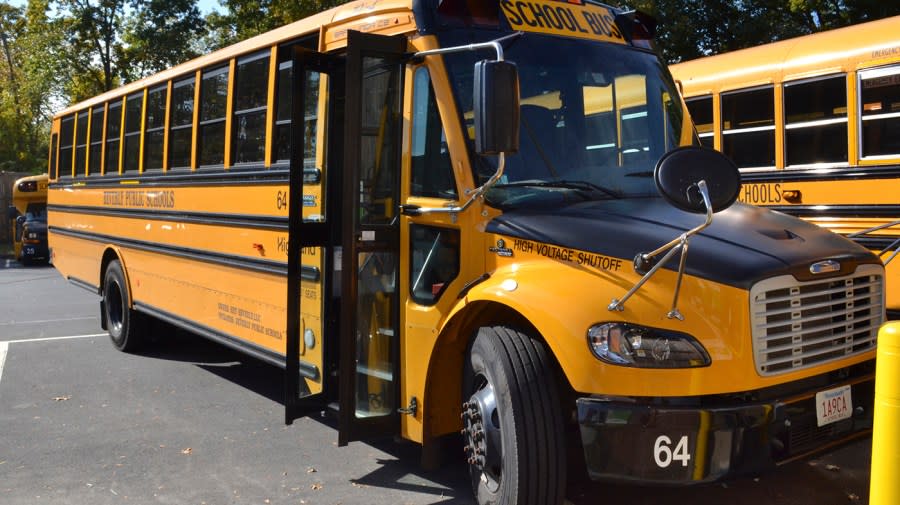Schools intensify their climate change efforts as temperatures rise

Last year was the hottest on record, according to data released this week, and U.S. schools are ramping up their fight against climate change after President Biden announced a $1 billion investment into electric school buses.
Schools are slowly transitioning towards greener paths of energy consumption, an important step as K-12 public schools in the U.S. consume 8 percent of the energy used by commercial buildings, according to the Sierra Club.
“When you think about our emissions from society as a whole, our schools are also responsible for a part of that carbon pollution because they have a lot of needs to be able to serve children and students more broadly,” said Laura Schifter, fellow with the Aspen Institute and director of This is Planet Ed.
“And so actually thinking about the opportunity to reduce our carbon pollution within schools is very much necessary. It’s something that our schools need to be doing,” Schifter added.
The Biden administration announced this week it is investing $1 billion so 67 schools and districts could replace their school bus fleet with low-emission and zero-emission buses.
The president’s initiative on electric school buses has totaled $1.84 billion so far, with the Environmental Protection Agency saying 5,000 low- or zero-emission buses have been funded.
“Every school day, 25 million children ride our nation’s largest form of mass transit: the school bus. The vast majority of those buses run on diesel, exposing students, teachers, and bus drivers to toxic air pollution,” Vice President Harris said in a statement announcing the latest $1 billion in funding.
“As part of our work to tackle the climate crisis, the historic funding we are announcing today is an investment in our children, their health, and their education. It also strengthens our economy by investing in American manufacturing and America’s workforce,” she added.
Top Stories from The Hill
Greene claims she threatened Johnson with motion to vacate over border deal
Swalwell argues Trump being treated ‘better’ than normal criminal defendants
The buses, however, are just one part of a bigger picture on how schools have been working to make their operations more environmentally friendly.
Schifter had previously pointed out there are 100,000 K-12 public schools in the U.S. that sit on 2 million acres of land, operate 480,000 buses and produce 53,000 tons of food waste, meaning they have ample opportunities to help bring about a greener future.
One of the biggest ways schools have changed their operations is by reevaluating what type of energy they are using to run their buildings.
Solar power in schools has become increasingly popular, going up 81 percent from 2014 to 2019, according to Generation 180, a nonprofit that advocates for clean energy. However, that still means only 5.1 percent of K-12 schools are using solar energy.
Schifter highlighted a school in Batesville, Ark., that has found that switching to better energy sources will help reduce their costs in the long run, freeing up more money to put toward staff salaries.
“They had an opportunity to build a solar array with an agreement that they wouldn’t have to pay the cost of installing the solar array, and then they’d enter into a contract that would enable them to have a lot of money saved up through their energy use over time,” she said. “And what they’ve been able to do is actually use the savings from the solar to go in and increase teacher pay so really thinking creatively about this.”
Another big way schools are tackling climate change is by switching their methods of heating and cooling, a matter of some urgency as temperatures rise around the globe.
The European Union’s Copernicus Climate Change Service announced Tuesday 2023 was the hottest year in the 173 the group has been keeping record.
On Friday, the U.S.’s National Oceanic and Atmospheric Administration (NOAA) confirmed that data.
“Not only was 2023 the warmest year in NOAA’s 174-year climate record — it was the warmest by far. A warming planet means we need to be prepared for the impacts of climate change that are happening here and now, like extreme weather events that become both more frequent and severe,” chief scientist Sarah Kapnick said in a statement.
The changes last year were felt by countless schools, particularly in areas not used to the heat, as they had no air conditioning and ended up having to close schools down, sometimes for days at a time.
Schools can install heat pumps that “significantly reduce the climate impact” while still cooling their buildings, said Holly Bender, chief energy officer at the Sierra Club.
“One of the first big opportunities is to replace fossil fuel boilers that heat buildings with heat pumps which are both much cleaner from a climate and air pollution standpoint and also provide really critical cooling for schools that don’t currently have them,” Bender said.
And advances in greener schools also help the districts educate a new generation that is more exposed to thinking about their impact on the environment and how energy works.
“There’s various evidence that if you teach people about what causes emissions, they think more about the different activities and they learn about the consequences of those emissions,” said Jacqueline Klopp, co-director of the Center for Sustainable Urban Development at Columbia University.
“They will often be empowered to make choices in their own lives, to reduce their footprint. Schools are just really important,” Klopp added.
For the latest news, weather, sports, and streaming video, head to The Hill.

